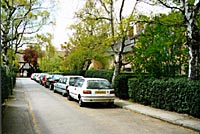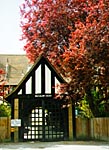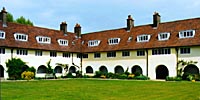 First there is Heath Close with continuous terraces typical of Parker's dark brick manner, although the frontage is almost straight and its formality emphasised by a deep plaster coving.
First there is Heath Close with continuous terraces typical of Parker's dark brick manner, although the frontage is almost straight and its formality emphasised by a deep plaster coving.
 The elevations are ingeniously scooped out to provide balconies at first floor level with prominent rows of balusters in the same black painted timber as the windows.
The elevations are ingeniously scooped out to provide balconies at first floor level with prominent rows of balusters in the same black painted timber as the windows.
At the end of the close is the entrance to Waterlow Court, a masterpiece by M H Baillie Scott, one of the most original English architects of the turn of the century, who had (and still has) a great reputation on the Continent where his competition-winning entry for the palace interior of Prince Ludwig of Hesse had attracted much attention. Baillie Scott practised in the Isle of Man until 1903 and there is an element of the Celtic faery in his designs, mingling stark originality with sentimental whimsy.

At Waterlow Court there is whimsy in the entrance, a deep timber cloister which cleverly prolongs the atmosphere of Heath Close, while emphasising the privacy of the Court. It is spatially an extremely ingenious conception -Baillie Scott may have derived it from Philip Webb's entrance cloister at Great Tangley Manor, Surrey. Waterlow Court itself was built as a communal residence for single women by the Improved Industrial Model Dwellings Company (builders of the Waterlow tenements in the slums of inner London).
 The courtyard shows Baillie Scott at his starkest, with sheer unbroken white plaster walls and smooth undecorated round-arched cloisters. The materials derive from Voysey, the cloisters from Lutyens's house Orchards. What is peculiarly Baillie Scott himself is the softness and gentleness of the proportions; for example, his roofs have a curious comforting depth, which Mr. A S Gray suggests Baillie Scott saw in those country cottages which had originally been thatched but had later been tiled.
The courtyard shows Baillie Scott at his starkest, with sheer unbroken white plaster walls and smooth undecorated round-arched cloisters. The materials derive from Voysey, the cloisters from Lutyens's house Orchards. What is peculiarly Baillie Scott himself is the softness and gentleness of the proportions; for example, his roofs have a curious comforting depth, which Mr. A S Gray suggests Baillie Scott saw in those country cottages which had originally been thatched but had later been tiled.
|





